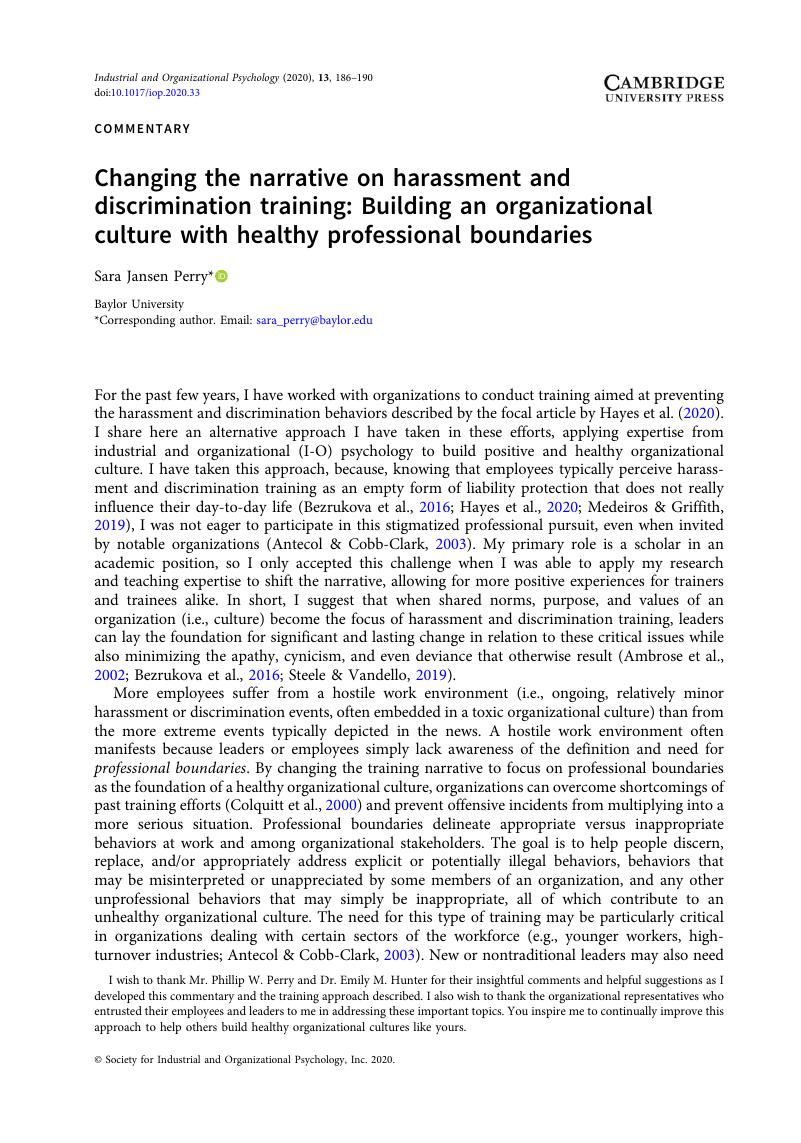No CrossRef data available.
Article contents
Changing the narrative on harassment and discrimination training: Building an organizational culture with healthy professional boundaries
Published online by Cambridge University Press: 28 July 2020
Abstract
An abstract is not available for this content so a preview has been provided. Please use the Get access link above for information on how to access this content.

- Type
- Commentaries
- Information
- Copyright
- © Society for Industrial and Organizational Psychology, Inc. 2020
References
Ambrose, M. L., Seabright, M. A., & Schminke, M. (2002). Sabotage in the workplace: The role of organizational injustice. Organizational Behavior and Human Decision Processes, 89, 947–965.CrossRefGoogle Scholar
Antecol, H., & Cobb-Clark, D. (2003). Does sexual harassment training change attitudes? A view from the federal level. Social Science Quarterly, 84, 826–842.CrossRefGoogle Scholar
Bezrukova, K., Spell, C. S., Perry, J. L., & Jehn, K. A. (2016). A meta-analytical integration of over 40 years of research on diversity training evaluation. Psychological Bulletin, 142, 1227–1274.CrossRefGoogle ScholarPubMed
Coats, E. J., Janoff-Bulman, R., & Alpert, N. (1996). Approach versus avoidance goals: Differences in self-evaluation and well-being. Personality and Social Psychology Bulletin, 22, 1057–1067.CrossRefGoogle Scholar
Colquitt, J. A., LePine, J. A., & Noe, R. A. (2000). Toward an integrative theory of training motivation: A meta-analytics path analysis of 20 years of research. Journal of Applied Psychology, 85, 678–707.CrossRefGoogle Scholar
Hayes, T. L., Kaylor, L. E., & Oltman, K. A. (2020). Coffee and controversy: How applied psychology can revitalize sexual harassment and racial discrimination training. Industrial and Organizational Psychology: Perspectives on Science and Practice, 13(2), XXX–XXX.CrossRefGoogle Scholar
Kluger, A. N., & DeNisi, A. (1996). The effects of feedback interventions on performance: A historical review, a meta-analysis, and a preliminary feedback intervention theory. Psychological Bulletin, 119, 254–284.CrossRefGoogle Scholar
Lacerenza, C. N., Reyes, D. L., Marlow, S. L., Joseph, D. L., & Salas, E. (2017). Leadership training design, delivery, and implementation: A meta-analysis. Journal of Applied Psychology, 102, 1686–1718.CrossRefGoogle ScholarPubMed
Lee, S. Y., Hanson, M. D., & Cheung, H. K. (2019). Incorporating bystander intervention into sexual harassment training. Industrial and Organizational Psychology: Perspectives on Science and Practice, 12(1), 52–57.CrossRefGoogle Scholar
Medeiros, K., & Griffith, J. (2019). #Ustoo: How I-O psychologists can extend the conversation on sexual harassment and sexual assault through workplace training. Industrial and Organizational Psychology: Perspectives on Science and Practice, 12(1), 1–19.CrossRefGoogle Scholar
Preusser, M. K., Lynn, K., & Nordstrom, C. R. (2011). Sexual harassment training: Person versus machine. Public Personnel Management, 40(1), 47–62.CrossRefGoogle Scholar
Steele, L. M., & Vandello, J. A. (2019). When training backfires and what can be done about it. Industrial and Organizational Psychology: Perspectives on Science and Practice, 12(1), 30–33.CrossRefGoogle Scholar
Walsh, B. M., & Magley, V. J. (2019). Don’t forget the role of civility interventions in workplace sexual harassment. Industrial and Organizational Psychology: Perspectives on Science and Practice, 12(1), 39–41.CrossRefGoogle Scholar


